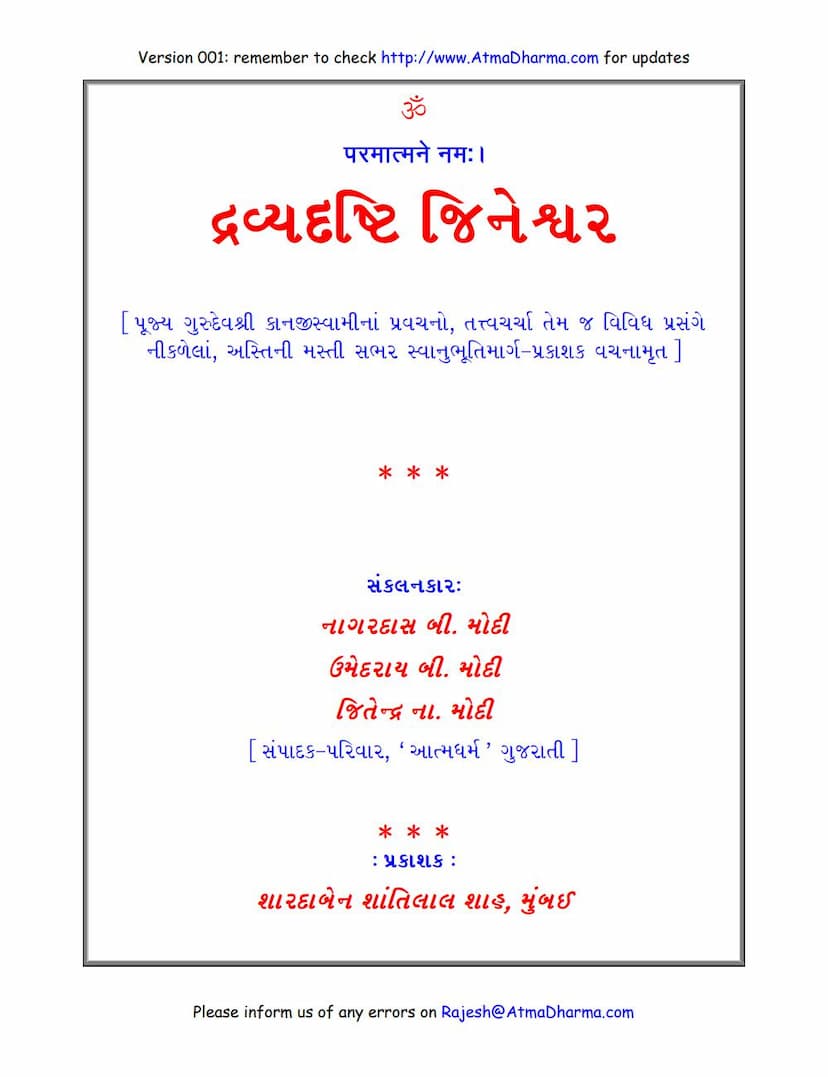Dravya Drushti Jineshvar
Added to library: September 1, 2025

Summary
This document is a collection of discourses and quotes attributed to Pujya Gurudev Shri Kanji Swami, compiled by Atmadharm Parivar and published by Sharadaben Shantilal Shah in Mumbai. Titled "Dravya Drushti Jineshvar," the text focuses on the core Jain philosophy of substance (Dravya) and perspective (Drushti), particularly emphasizing the path of liberation through self-realization and detachment.
Here's a comprehensive summary of the key themes and teachings presented in the text:
Core Philosophical Tenets:
- Dravya Drishti (Substantial View): The central theme revolves around understanding the true nature of reality from the perspective of substance (Dravya). This means recognizing the soul (Jiva) as an eternal, unchanging, and pure essence, distinct from its transient modifications (Paryaya) and external entities (Agiva).
- Soul as Pure Consciousness: The soul is repeatedly described as pure, sentient, omniscient (potentially), blissful, and characterized by knowledge (Gyan), vision (Darshan), and inherent power. It is the true self, the ultimate reality, and the focus of spiritual pursuit.
- Non-Duality and Unity: The teachings emphasize the fundamental unity of all souls, recognizing that every living being, from the simplest organism to the most complex, possesses the same divine, pure soul essence. The inherent divinity within is highlighted.
- Rejection of External Reliance: There's a strong emphasis on understanding that true liberation and happiness do not come from external factors like rituals, deities, scriptures, or even virtuous actions (like Punya). The focus is solely on the internal realization of the soul's true nature.
- The Real "I": The discourses constantly steer the listener away from identifying with the body, senses, emotions (like Rag, Dvesh, Krodh, Moh), or external circumstances. The true "I" is the pure, unchanging, sentient soul.
- The Power of Self-Realization: The ultimate goal is the direct experience (Anubhuti) of the soul's true nature. This realization is presented as the path to liberation, the eradication of suffering, and the attainment of eternal bliss.
Key Concepts and Teachings:
- Detachment (Vairagya): The discourses advocate for detachment from worldly pleasures, relationships, possessions, and even virtuous activities (like Punya) when they become an object of attachment, as they are ultimately transient and cannot lead to ultimate liberation.
- Self-Effort (Purusharth): While acknowledging divine grace and the influence of external factors (like the teachings of Tirthankaras), the emphasis is on the soul's own effort and introspection to realize its inherent nature.
- Non-Attachment to Purity/Perfection: Even pure spiritual states (like purified thoughts or states of meditation) are considered transient Paryayas, not the ultimate Dravya. The focus remains on the unchanging substance, not its momentary manifestations.
- The Importance of Right Faith (Samyak Darshan) and Right Knowledge (Samyak Gyan): The text stresses that true understanding (Prakriti ka Prakar) and right faith in the soul's nature are paramount for spiritual progress. This involves discerning the real self from the non-self.
- The Nature of Karma and Liberation: Karma is presented as a consequence of wrongdo external identification and attachment. Liberation (Moksha) is achieved by eradicating this wrong perception and realizing the soul's inherent purity and freedom.
- The "Krámabaddha" (Chronologically Determined) Principle: Some sections touch upon the concept that events unfold in a predetermined sequence, but this is balanced with the emphasis on self-effort in understanding and realizing the soul's nature.
- Rejection of Ritualism: The teachings subtly discourage excessive focus on outward rituals and ceremonies, advocating instead for the internal realization of the soul's true nature.
- The Guru's Role: The guidance of a true spiritual master (Guru) is acknowledged as crucial for navigating the subtle path of self-realization.
Emphasis on Certain Phrases and Concepts:
- "Me Hi Parmatma Hoon" (I am the Supreme Soul): This phrase, or variations of it, is frequently used to instill the idea of the soul's inherent divinity.
- "Jñātā-Drashtā" (Knower-Seer): This epithet for the soul highlights its passive, observational nature, unattached to actions or their results.
- "Prakriti Ka Prakar" (Nature of Reality): The importance of understanding the true nature of reality, as it is, is a recurring theme.
- "Vairagya" (Detachment): Emphasized repeatedly as a key step in spiritual progress, leading to the shedding of worldly attachments.
- "Antarmukh" (Inward Turning): The essential practice advocated is to turn the attention inwards, away from external phenomena, towards the soul.
Overall Tone and Style:
The discourses are presented in a direct, often repetitive, and emphatic style, aiming to penetrate the listener's understanding and impress upon them the eternal truths of Jain philosophy. The language is accessible, often using analogies and straightforward explanations to convey profound spiritual concepts. The tone is one of deep compassion, urging listeners towards self-awareness and ultimate liberation. The text is rich in aphorisms and pointed sayings that encapsulate the essence of spiritual wisdom.